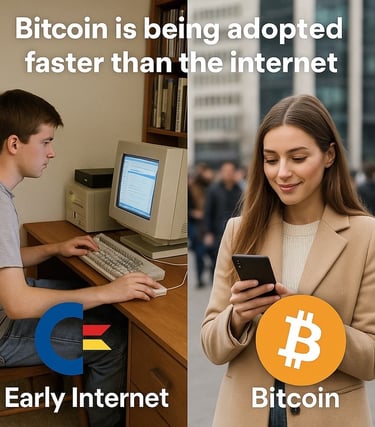Bitcoin adoption Vs Internet
Bitcoin Pace Of Adoption


Bitcoin Adoption vs. Internet Adoption: Are We Seeing History Repeat Itself?
When the internet first emerged, few could have predicted how radically it would reshape every corner of modern life. Fast-forward a few decades, and Bitcoin — once dismissed as a fringe experiment — is now following a surprisingly familiar path.
But how closely does Bitcoin adoption really mirror the early days of the internet?
Let’s dig into the data, the timelines, and what this comparison reveals about Bitcoin’s future.
1. The Curve Looks Familiar
Adoption curves for new technologies often follow a predictable pattern:
Innovation
Early adoption
Disruption
Mass adoption
The internet took roughly 30 years to go from concept (1969) to mainstream (late 1990s–early 2000s). Bitcoin, launched in 2009, is barely over a decade old — but its growth rate is echoing that of the internet in striking ways.
📈 According to multiple studies, Bitcoin adoption is currently where the internet was around 1997.
That means we could be in the “AOL dial-up” phase of Bitcoin — still early, but accelerating fast.
2. Global Reach Is Increasing Rapidly
The internet reached its first 100 million users in around 7 years. Bitcoin hit a similar milestone in under 12 years, with adoption now growing 2x faster than the internet did at the same stage.
What’s accelerating Bitcoin’s global reach?
Smartphone penetration (you can now access Bitcoin from anywhere)
Social media (financial literacy is spreading faster than ever)
Macroeconomic instability (many are turning to Bitcoin in countries with inflation or capital controls)
3. Infrastructure Is Catching Up
In the 90s, internet adoption was limited by a lack of infrastructure: modems were slow, websites were clunky, and users had no idea what a “browser” was.
Similarly, Bitcoin’s infrastructure is still developing:
Wallets are getting more user-friendly
Lightning Network is improving scalability
Regulations are being established (albeit slowly)
Institutional involvement is growing (BlackRock, Fidelity, etc.)
As infrastructure improves, friction goes down — and adoption accelerates.
4. Skepticism Mirrors the Past
Let’s not forget: the internet was also met with skepticism.
“The internet is just a fad.”
“No one will shop online.”
“Why would anyone use email?”
Now, we’re hearing echoes of that doubt:
“Bitcoin is a bubble.”
“It’s only for criminals.”
“It’s too volatile to be taken seriously.”
History shows that early skepticism is common for paradigm-shifting technologies — and it often signals you’re still early.
5. What This Means for the Future
If Bitcoin continues tracking the internet’s adoption curve, the coming decade could bring:
Mainstream integration in finance, commerce, and global remittances
Exponential user growth
Price appreciation as demand outpaces supply
More products, apps, and services built on Bitcoin’s base layer
In short, we're not late — we’re early. But like the internet boom, the biggest rewards went to those who paid attention before mass adoption kicked in.
Final Thoughts
Comparing Bitcoin to the internet isn’t just about growth rates — it’s about understanding what happens when a revolutionary technology collides with global demand for change.
Bitcoin is following a familiar pattern. The question is:
👉 Will you be a late adopter like many were with the internet… or will you lean in before the wave hits?
📩 Book a free 15-minute call with a Freedom Adviser today and start building real wealth — the Bitcoin way